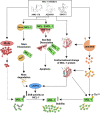Targeting MCL-1 protein to treat cancer: opportunities and challenges
- PMID: 37601693
- PMCID: PMC10436212
- DOI: 10.3389/fonc.2023.1226289
Targeting MCL-1 protein to treat cancer: opportunities and challenges
Abstract
Evading apoptosis has been linked to tumor development and chemoresistance. One mechanism for this evasion is the overexpression of prosurvival B-cell lymphoma-2 (BCL-2) family proteins, which gives cancer cells a survival advantage. Mcl-1, a member of the BCL-2 family, is among the most frequently amplified genes in cancer. Targeting myeloid cell leukemia-1 (MCL-1) protein is a successful strategy to induce apoptosis and overcome tumor resistance to chemotherapy and targeted therapy. Various strategies to inhibit the antiapoptotic activity of MCL-1 protein, including transcription, translation, and the degradation of MCL-1 protein, have been tested. Neutralizing MCL-1's function by targeting its interactions with other proteins via BCL-2 interacting mediator (BIM)S2A has been shown to be an equally effective approach. Encouraged by the design of venetoclax and its efficacy in chronic lymphocytic leukemia, scientists have developed other BCL-2 homology (BH3) mimetics-particularly MCL-1 inhibitors (MCL-1i)-that are currently in clinical trials for various cancers. While extensive reviews of MCL-1i are available, critical analyses focusing on the challenges of MCL-1i and their optimization are lacking. In this review, we discuss the current knowledge regarding clinically relevant MCL-1i and focus on predictive biomarkers of response, mechanisms of resistance, major issues associated with use of MCL-1i, and the future use of and maximization of the benefits from these agents.
Keywords: BCL-2 family; BCL-2 family proteins; MCL-1 inhibitors; MCL-1 protein; apoptosis; cancer therapy.
Copyright © 2023 Tantawy, Timofeeva, Sarkar and Gandhi.
Conflict of interest statement
Author VG has received research grants from Pharmacyclics, Acerta, Gilead, Sunesis, ClearCreek Bio, Infinity, and Loxo Oncology. The remaining authors declare that the research was conducted in the absence of any commercial or financial relationships that could be construed as a potential conflict of interest.
Figures





Similar articles
-
Lymphoma cells lacking pro-apoptotic BAX are highly resistant to BH3-mimetics targeting pro-survival MCL-1 but retain sensitivity to conventional DNA-damaging drugs.Cell Death Differ. 2023 Apr;30(4):1005-1017. doi: 10.1038/s41418-023-01117-0. Epub 2023 Feb 8. Cell Death Differ. 2023. PMID: 36755070 Free PMC article.
-
Side-by-side comparison of BH3-mimetics identifies MCL-1 as a key therapeutic target in AML.Cell Death Dis. 2019 Dec 4;10(12):917. doi: 10.1038/s41419-019-2156-2. Cell Death Dis. 2019. PMID: 31801941 Free PMC article.
-
The first MCL-1-selective BH3 mimetics have therapeutic potential for chronic lymphocytic leukemia.Crit Rev Oncol Hematol. 2016 Apr;100:32-6. doi: 10.1016/j.critrevonc.2016.02.003. Epub 2016 Feb 11. Crit Rev Oncol Hematol. 2016. PMID: 26899021 Review.
-
Recent Advances in Cancer Drug Development: Targeting Induced Myeloid Cell Leukemia-1 (Mcl-1) Differentiation Protein.Curr Med Chem. 2017;24(40):4488-4514. doi: 10.2174/0929867324666170912092659. Curr Med Chem. 2017. PMID: 28901269 Review.
-
NA1-115-7, from Zygogynum pancheri, is a new selective MCL-1 inhibitor inducing the apoptosis of hematological cancer cells but non-toxic to normal blood cells or cardiomyocytes.Biomed Pharmacother. 2022 Oct;154:113546. doi: 10.1016/j.biopha.2022.113546. Epub 2022 Aug 18. Biomed Pharmacother. 2022. PMID: 35988426
Cited by
-
Potential biomarkers for MCL1 inhibitor sensitivity.Cell Signal (Middlet). 2024;2(1):144-147. doi: 10.46439/signaling.2.046. Cell Signal (Middlet). 2024. PMID: 39802137 Free PMC article.
-
Major Traumatic Injury and Exposure to Mitochondrial-Derived Damage-Associated Molecular Patterns Promotes Neutrophil Survival Accompanied by Stabilisation of the Anti-Apoptotic Protein Mcl-1.Cells. 2025 May 21;14(10):754. doi: 10.3390/cells14100754. Cells. 2025. PMID: 40422258 Free PMC article.
-
MNDA, a PYHIN factor involved in transcriptional regulation and apoptosis control in leukocytes.Front Immunol. 2024 Apr 12;15:1395035. doi: 10.3389/fimmu.2024.1395035. eCollection 2024. Front Immunol. 2024. PMID: 38680493 Free PMC article. Review.
-
Oleuropein regulates ubiquitination-mediated Mcl-1 turnover and exhibits antitumor activity.Cancer Gene Ther. 2025 Jul;32(7):793-805. doi: 10.1038/s41417-025-00921-9. Epub 2025 Jun 12. Cancer Gene Ther. 2025. PMID: 40506561
-
Myelodysplastic Neoplasms (MDS): The Current and Future Treatment Landscape.Curr Oncol. 2024 Apr 3;31(4):1971-1993. doi: 10.3390/curroncol31040148. Curr Oncol. 2024. PMID: 38668051 Free PMC article. Review.
References
Publication types
LinkOut - more resources
Full Text Sources

